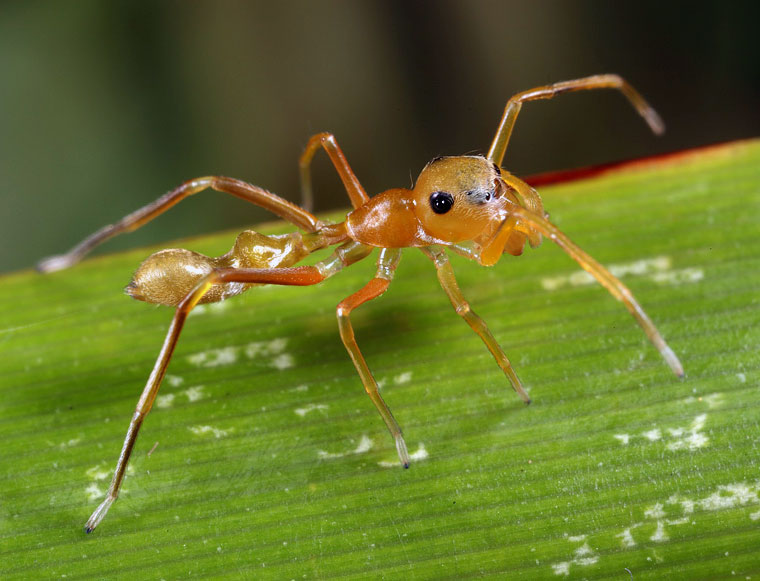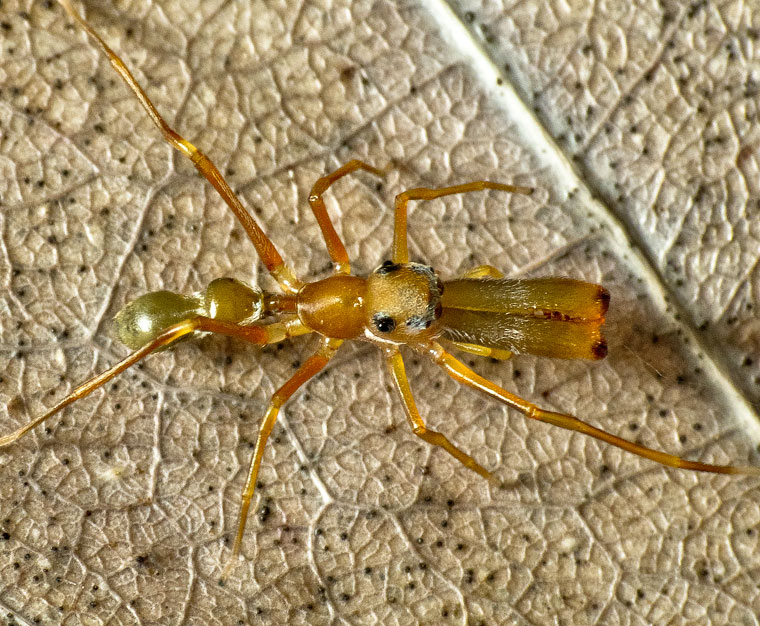Ants; ferocious and efficient predators
that can overwhelm prey much larger than themselves through tactical attacks,
strong mandibles, a sting or the ability to spray formic acid on their target and
the force of sheer numbers. It is no surprise then that ants have had
significant impacts on the evolution of other organisms through symbiotic
relationships, providing resources and being the subject of mimicry (McIver,
1993). Myrmecomorphy is the term for species that resemble ants
morphologically, behavioural, chemically or texturally (McIver, 1993). Over
2000 species of myrmecomorphic arthropods from 54 families have been described
so far including spiders, Leaf bugs (Miridae), broad-headed bugs (Alydidae), mantises
(Mantidae), and even other Hymenopterans including parasitic wasp species from
the Diapriidae family (McIver, 1993).
Myrmecomorphic
spiders have developed some of the most amazing morphological traits in order
to mimic ants considering they are not even in the same taxonomic class. Some species of
ant mimic spiders use their extra pair of legs as fake antenna, the
cephalothorax has narrowed in the centre used to give the illusion of 3 body
segments, some species have enlarged pedipalps/chelicerae used to mimic the
ants head, reflective hairs to appear shiny or smooth textured and colour spots
to mimic compound eyes are just some of the adaptions made (McIver, 1993).
 |
| Aphantochilus rogersi (left) captures a turtle ant (Cephalotes sp.). Image taken in Ecuador courtesy of Alex Wild. |
Spiders don’t just use this
mimicry in order to prey on the ants, some use batesian mimicry to avoid being
eaten themselves. Here in Australia we have an amazing little Green
Weaver Ant (Oecophylla smaragdina)
mimic - Myrmarachne smaragdina
– this species has adopted both morphological and behavioural features of the
ants in order to avoid predation and lives near colonies of O. smaragdina without being attacked (Ceccarelli,
2008).
 |
Female Myrmarachne
smaragdina – Green weaver ant mimic spider. Photo taken in Darwin courtesy
of Dr Greg Anderson.
|
 |
| Male
Myrmarachne smaragdina – Green weaver
ant mimic spider. Photo taken in Cairns courtesy of Robert Whyte. |
References:
McIver, JD 1993, ‘Myrmecomorphy: morphological and behavioural mimicry of ants’, Annual Review of Entomology, vol. 38, pp. 351-379.
Ceccarelli, FS 2008, ‘Behavioral mimicry in Myrmarachne species (Araneae, Salticidae) from North Queensland, Australia’, Journal of Arachnology, vol. 36, no. 2, pp. 344-351.
Image 1: Ant Enemies, Alex Wild: The diversity of insects, viewed 9 May 2015, 2015, <http://www.alexanderwild.com/Ants/Taxonomic-List-of-Ant-Genera/Solenopsis/i-RZcnVdD/1/L/Diapriidae4-L.jpg>
Image 2: Amazing Arachnids, Alex Wild: The diversity of insects, viewed 9 May 2015, <http://www.alexanderwild.com/Ants/Taxonomic-List-of-Ant-Genera/Cephalotes/i-6WhGGgx/2/XL/Aphantochilus3-XL.jpg>
Image 3 (female): Whyte, R & Anderson, G 2010, Salticidae Jumping spiders, Queensland Museum, viewed 9 May 2015, <http://www.arachne.org.au/_dbase_upl/smaragIMG_0342-resized.jpg>
Image 4 (male): Whyte, R & Anderson, G 2010, Salticidae Jumping spiders, Queensland Museum, viewed 9 May 2015, <http://www.arachne.org.au/_dbase_upl/P1000959Iain__29_Dec_11_Myrm.jpg>
|

That female green ant mimic spider is amazing! The male – not so much A very interesting story here. It’s very interesting that there is convergence in the use of mimicry for very different purposes: protection from predation (Batesian) and hiding to predate (aggressive). I probably already know the answer to this question, but are there any other species (not arthropods) that mimic ants? Also, are there any ants that mimic other types of ants? Cool post!
ReplyDeleteAccording to Lev-Yadun (2009) there are some species in the Passiflora genus that are believed to use ant mimicry (with dark dots and stripes) as a defence against predation from ants as well as butterflies, the butterflies prefer to lay their eggs on plants without any predators. Some have dots on the anthers/stamen ( e.g. P. amythistina: https://c1.staticflickr.com/9/8466/8145087341_4039ed650e_b.jpg ), some on the petals (e.g. P. gracilis: http://pics.davesgarden.com/pics/2001/09/26/Tim/d79b0f.jpg ).
ReplyDeleteApparently mimicry in social insects is rare as they develop different defence mechanisms, however there are a couple of batesian ant mimics: Camponotus bendigensis (mimic another species of ant with a painful sting) and Polyrhachis rufipes (can follow another sp. chemical trail to steal food), however the first experimental evidence was found by Ito et al (2004) with Camponotus sp. that mimic Crematogaster inflata. An experiment with chicks showed that C. inflata is unpalatable whereas Camponotus sp. was palatable, after eating C. inflata the chicks no longer ate the Camponotus sp. In the field the mimics were only observed on the models trails, but in lab tests it showed that the mimic is not following the other ants trail - the mimics nest near the model so this may be why they were in the same foraging sites.
References:
Lev-Yadun, S 2009, 'Ant mimicry by Passiflora flowers?', Israel Journal of Entomology, vol. 39, pp. 159-163.
Ito, F, Hashim, R, Huei, YS, Kaufmann, E, Akino, T & Billen, J 2004, 'Spectacular Batesian mimicry in ants', Naturwissenschaften, vol. 91, pp.481–484.